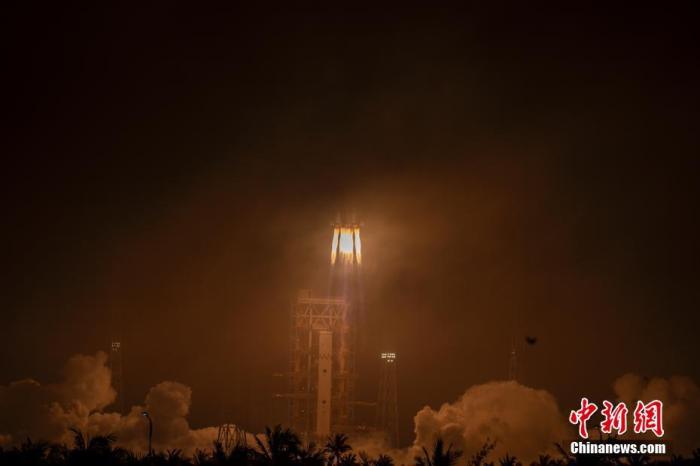China News Service, Beijing, May 10th (Wang Xuejiao and Ma Shuaisha) In the early morning of May 10th, the space "courier boy" Tianzhou-4 cargo spacecraft was carried by the exclusive "logistics vehicle" Long March 7 Yao-5 carrier rocket. , successfully lifted off, and embarked on the journey of cargo transportation on the space station.
The researchers equipped Tianzhou-4 with triple security protection, created a "logistics tracking network" and giant energy "wings" to ensure the safe "signing" of the "space express".
Three safety protection measures to protect the safety of "logistics vehicles"
Rocket launch has certain risks. The ground safety remote control system developed by China Electric Power Group is a necessary condition for rocket launch. It is used in the active part of the launch mission. Through real-time dynamic monitoring of the data during the rocket launch, the state of the rocket can be analyzed and judged.
Once the flight is abnormal, the device will send a special command to start the self-destruction device to avoid the damage caused by the rocket falling to the ground to the greatest extent.
A pulse coherent transponder is also installed on the launch vehicle. As an important outer ballistic measurement device in the active section of the rocket flight, it can cooperate with the ground radar to complete the real-time track measurement of the launch vehicle throughout the whole process, and transmit the precise position and speed information of the rocket in real time. Research and judge normal flight to provide decision support.
In addition to relying on optical tracking and equipment on the rocket to monitor the rocket, the researchers are specially equipped with precision measurement radar.
For this launch, CETC has developed and equipped the first large-caliber radar and telemetry integrated system in China, which can achieve precise tracking of the rocket, and at the same time undertake the downlink reception and demodulation of the rocket telemetry signal, which is of great significance to the safe flight of the rocket.
At 1:56 on May 10, the Long March 7 Yao-5 carrier rocket carrying the Tianzhou-4 cargo spacecraft was successfully launched at the Wenchang Space Launch Site in China.
Photo by China News Agency reporter Luo Yunfei
Measurement and control "Tianluodi network" unblocked logistics and distribution channels
In the process of delivering materials, in order to capture and monitor the delivery trajectory of the "courier" in real time, scientific researchers have deployed multi-model unified measurement and control systems, telemetry systems, relay satellites, etc. The three-dimensional communication measurement and control network can track and capture the "express" position in all directions and without dead ends.
In the process of sending the vehicle into orbit by the rocket, the multi-model unified measurement and control system, telemetry system, and series of measurement and control communication equipment are woven into an efficient and reliable "air-ground information highway network", and the rocket and the vehicle are accurately measured by receiving and sending instructions. The speed, distance, flight attitude and angle of the rocket provide accurate data for the launch of the rocket and the successful entry of Tianzhou-4 into orbit, and control the aircraft to fly according to the predetermined trajectory.
At sea, the new generation of shipborne measurement radar can obtain the same high measurement accuracy as the ground when the measurement ship is swaying, effectively making up for the lack of land measurement time and extending the measurement arc.
"Super-stable" solar cell array adds giant energy "wings" to the flying sky
It is reported that the electricity consumption of the Chinese space station complex for one day of continuous work is equivalent to the electricity consumption of a family for about a year.
In order to meet such a high demand for electricity, China Electric Power has created unique giant energy "wings" for each spacecraft of the space station. They are combined like a huge "energy gas station".
Among them, the domestic original semi-rigid solar cell array "wings" built for the Tianzhou cargo spaceship has the advantages of high energy and high power. The power supply capacity of the two wings exceeds 8kW, and its power generation in one day can meet the needs of ordinary families for more than half a month. energy used.
As a high-voltage, 10,000-watt high-power solar cell array product, the semi-rigid solar cell array takes "carbon fiber frame + glass fiber grid structure" as the substrate, and inherits the semi-rigid solar cell array technology of Tianzhou-1. , The solar cell array products used by the Tianzhou-4 cargo spacecraft have further improved the efficiency of triple-junction gallium arsenide solar cells, solved the problems of anti-static charging/discharging of low-orbit high-voltage solar cell arrays, and lowered the operating temperature of solar cell arrays. , so that the "big physique" of Tianzhou-4 can also "fly into the sky" and smoothly transport various materials to space.
(Finish)

